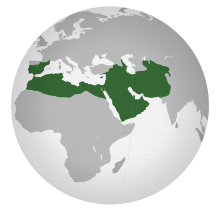List of Caliphs
| Khalīfah (Caliph) خَليفة | |
|---|---|
|
| |
| Style | Amir al-Mu'minin |
| Residence |
al-Madīnah al-Munawwarah (Medina) al-Kūfah (Kufa) Dimashq (Damascus) Baġdād (Baghdad) Qāhirah (Cairo) Qustantiniyye (Constantinople) |
| Precursor | Muhammad as Islamic prophet |
| Formation | 8 June 632 |
| First holder | Abū Bakr as-Șiddīq |
| Final holder | Abdülmecid II |
| Abolished | 3 March 1924 |
This is a list of people who have held the title of Caliph, the supreme religious and political leader of an Islamic state known as the Caliphate, and the title for the ruler of the Islamic Ummah, as the political successors to Muhammad. All years are according to the Common Era.
Background
A few months before his death, the Islamic prophet Muhammad delivered a sermon to over 100,000 Muslims at the event of Ghadir Khumm. In the sermon, he declared Ali ibn Abi Talib to be his successor. He described Ali with several leadership titles in the sermon, including "Mawla," "Imam," "Ameer," and "Khalifah."[1] After the sermon, Muhammad instructed everyone to pledge allegiance to Ali. According to both Shia and Sunni sources, Abu Bakr, Umar, and Uthman were all among those who pledged allegiance to Ali at the event.[2][3][4]
After Muhammad's death, however, some of Muhammad's companions left and gathered at a place known as Saqifa. At Saqifa, Umar pledged allegiance to Abu Bakr, despite their previous pledges of allegiance to Ali. Abu Bakr then assumed political power, and his supporters became known as the Sunnis. Despite that, a group of Muslims kept their allegiance to Ali. These people, who became known as Shias, held that while Ali's right to be the political leader may have been taken, he was still the religious and spiritual leader after Muhammad.
Ecumenical caliphates
Rashidun Caliphate (8 June 632 – 29 January 661)
| # | Calligraphic | Name (and titles) | Reign | Relationship with Muhammad | Parents | House | Notes |
|---|---|---|---|---|---|---|---|
| 1 | Abū Bakr (أبو بكر) 'Abdullah Șaḥābī Aṣ-Ṣiddīq |
8 June 632 – 22 August 634 |
|
Banu Taim |
| ||
| 2 |  |
ʿUmar ibn al-Khattab (عمر بن الخطاب) Șaḥābī Al-Farooq Amir al-Mu'minin |
23 August 634 – 3 November 644 |
|
|
Banu Adi |
|
| 3 |  |
'Uthman ibn 'Affan (عثمان بن عفان) Șaḥābī Dhun Nurayn Amir al-Mu'minin |
11 November 644 – 20 June 656 |
|
Banu Ummaya |
| |
| 4 |  |
'Ali ibn Abi-Talib (علي بن أبي طالب) Șaḥābī Amir al-Mu'minin |
20 June 656 – 29 January 661 |
|
Banu Hashim |
|
Hasan ibn Ali's Caliphate (661)
| # | Calligraphic | Name (and titles) | Reign | Relationship with Muhammad (or previous Caliph) | Parents | House | Notes |
|---|---|---|---|---|---|---|---|
| 5 |  |
Ḥasan ibn ʿAli (الحسن بن علي) Ahl al-Bayt al-Mujtaba[5] |
661 (six or seven months) |
|
|
Banu Hashim |
|
Umayyad Caliphate (661 – 6 August 750)
| # | Name (and titles) | Reign | Relationship with Muhammad (or previous Caliph) | Parents | Notes |
|---|---|---|---|---|---|
| 6 | Mu'awiyah I (معاوية) Șaḥābī Amir al-Mu'minin |
661 – 29 April or 1 May 680 |
|
||
| 7 | Yazid I (يزيد) |
680 – 11 November 683 |
|
|
|
| 8 | Mu'awiyah II (معاوية الثاني) Amir al-Mu'minin |
November 683 – 684 |
|
|
|
| 9 | Marwan I (مروان بن الحکم) Șaḥābī Amir al-Mu'minin |
684 – 7 May 685 |
|
| |
| 10 | 'Abd al-Malik ibn Marwan (عبد الملك بن مروان) Amir al-Mu'minin |
685 – 8 October 705 |
|
|
|
| 11 | Al-Walid I (الوليد الأول) Amir al-Mu'minin |
October 705 – 23 February 715 |
|
|
|
| 12 | Sulayman ibn 'Abd al-Malik (سلیمان بن عبدالملک) Amir al-Mu'minin |
February 715 – 22 September 717 |
|
|
|
| 13 | 'Umar ibn 'Abd al-'Aziz (عمر بن عبد العزيز) Amir al-Mu'minin |
September 717 – February 720 |
|
|
|
| 14 | Yazid II (يزيد الثاني) Amir al-Mu'minin |
10 February 720 – 26 January 724 |
|
|
|
| 15 | Hisham ibn 'Abd al-Malik (هشام بن عبد الملك) Amir al-Mu'minin |
26 January 724 – 6 February 743 |
|
|
|
| 16 | Al-Walid II (الوليد الثاني) Amir al-Mu'minin |
6 February 743 – 17 April 744 |
|
|
|
| 17 | Yazid III (يزيد الثالث) Amir al-Mu'minin |
April 15 to October 3 or 4, 744 |
|
|
|
| 18 | Ibrahim ibn al-Walid (ابراهيم ابن الوليد) Amir al-Mu'minin |
744 (few weeks) |
|
|
|
| 19 | Marwan II (مروان بن محمد) Amir al-Mu'minin |
744 – 6 August 750 |
|
Abbasid Caliphate (750–1258 and 1261–1517)
Caliphs of Baghdad (25 January 750 – 20 February 1258)
(Not accepted by the Muslim dominions in the Umayyad-ruled Iberian Peninsula and the Fatimid and Almohad-ruled parts of North Africa).[6][7]
| # | Regnal name | Personal name | Reign | Parents | Notes |
|---|---|---|---|---|---|
| 20 | As-Sāffaḥ | 'Abdallah Abul-'Abbās | 750 – 10 June 754 |
|
|
| 21 | Al-Mansur | Abu Ja'far 'Abdallah | 10 June 754 – 775 |
|
|
| 22 | Al-Mahdi | Abu 'Abdallah Muhammad | 775 – 4 August 785 |
|
|
| 23 | Al-Hadi | Abu Muhammad Musa | August 785 – 14 September 786 |
|
|
| 24 | Al-Rashid | Harun | 14 September 786 – 24 March 809 |
|
|
| 25 | Al-Amin | Muhammad | March 809 – 24/25 September 813 |
|
|
| 26 | Al-Ma'mun | Abu Jaʿfar 'Abdallah | September 813 – 9 August 833 |
|
|
| 27 | Al-Mu'tasim | Abū Ishaq Muhammad | 9 August 833 – 5 January 842 |
|
|
| 28 | Al-Wathiq | Abu Ja'far Harun | 5 January 842 – 10 August 847 |
|
|
| 29 | Al-Mutawakkil | Ja'far | 10 August 847 – 11 December 861 |
|
|
| 30 | Al-Muntasir | Abu Ja'far Muhammad | 861 – 7 or 8 June 862 |
|
|
| 31 | Al-Musta'in | Ahmad | 862 – 866 |
|
|
| 32 | Al-Mu'tazz | – | 866 – 869 |
|
|
| 33 | Al-Muhtadi | Abū Isḥāq Muḥammad | 869 – 21 June 870 |
|
|
| 34 | Al-Mu'tamid | Abu’l-ʿAbbās Aḥmad | 21 June 870 – 15 October 892 |
|
|
| 35 | Al-Mu'tadid | Abu'l-'Abbas Ahmad | October 892 – 5 April 902 |
|
|
| 36 | Al-Muktafi | Abu Ahmad ʿAlî | 5 April 902 – 13 August 908 |
|
|
| 37 | Al-Muqtadir | Abu al-Fadl Ja'far | 13 August 908 – 929 (First reign)
929 – 31 October 932 (Second reign) |
|
|
| 38 | Al-Qahir | Abu Mansur Muhammad | 929 (First reign)
31 October 932 – 934 (Second reign) |
|
|
| 39 | Ar-Radi | Abu al-'Abbas Muhammad | 934 – 23 December 940 |
|
|
| 40 | Al-Muttaqi | Abu Ishaq Ibrahim | 940 – 944 |
|
|
| 41 | Al-Mustakfi | 'Abdallah | September 944 – January 946 |
|
|
| 42 | Al-Muti | Abu al-Qasim al-Faḍl | January 946 – 974 |
|
|
| 43 | At-Ta'i | – | 974 – 991 |
|
|
| 44 | Al-Qadir | – | 1 November 991 – 29 November 1031 |
|
|
| 45 | Al-Qa'im | – | 29 November 1031 – 2 April 1075 |
|
|
| 46 | Al-Muqtadi | – | 2 April 1075 – February 1094 |
|
|
| 47 | Al-Mustazhir | – | February 1094 – 6 August 1118 |
|
|
| 48 | Al-Mustarshid | – | 6 August 1118 – 29 August 1135 |
|
|
| 49 | Ar-Rashid | – | 29 August 1135 – 1136 |
|
|
| 50 | Al-Muqtafi | – | 1136 – 12 March 1160 |
|
|
| 51 | Al-Mustanjid | – | 12 March 1160 – 20 December 1170 |
|
|
| 52 | Al-Mustadi | Hassan | 20 December 1170 – 30 March 1180 |
|
|
| 53 | An-Nasir | – | 2 March 1180 – 4 October 1225 |
|
|
| 54 | Az-Zahir | – | 5 October 1225 – 11 July 1226 |
|
|
| 55 | Al-Mustansir | Abû Ja`far | 11 July 1226 – 2 December 1242 |
|
|
| 56 | Al-Musta'sim | – | 2 December 1242 – 20 February 1258 |
|
|
| Interregnum | |||||
During the latter period of Abbasid rule, Muslim rulers began using other titles, such as Sultan.
Caliphs of Cairo (13 June 1261 – 22 January 1517)
The Cairo Abbasids were largely ceremonial Caliphs under the patronage of the Mamluk Sultanate that existed after the takeover of the Ayyubid dynasty.[10][11]
| # | Regnal name | Personal name | Reign | Parents | Notes |
|---|---|---|---|---|---|
| 57 | Al-Mustansir II | Abu al-Qasim Ahmad | 13 June 1261 – 28 November 1261 |
| |
| 58 | Al-Hakim I | Abu 'Abdullah Muhammad | 16 November 1262 – 19 January 1302 |
|
|
| 59 | Al-Mustakfi I | Abu ar-Rabi' Sulaiman | 20 January 1302 – February 1340 | ||
| 60 | Al-Wathiq I | Abu Ishaq Ibrahim | February 1340 – 17 June 1341 |
|
|
| 61 | Al-Hakim II | Abu al-'Abbas Ahmad | 1341 – 1352 | ||
| 62 | Al-Mu'tadid I | Abu Bakr | 1352 – 1362 | ||
| 63 | Al-Mutawakkil I | Abu 'Abdillah Muhammad | 1362 – 1377 (First reign)
1377 – 1383 (Second reign) 1389 – 9 January 1406 (Third reign) |
||
| 64 | Al-Mus'tasim | Abu Yahya Zakariya | 1377 (First reign)
1386 – 1389 (Second reign) |
||
| 65 | Al-Wathiq II | 'Umar | September 1383 – 13 November 1386 | ||
| 66 | Al-Musta'in | Abu al-Fadl al-'Abbas | 22 January 1406 – 9 March 1414 |
|
|
| 67 | Al-Mu'tadid II | Abu al-Fath Dawud | 1414 – 1441 |
|
|
| 68 | Al-Mustakfi II | Abu ar-Rabi' Sulayman | 1441 – 29 January 1451 | ||
| 69 | Al-Qa'im | Abu Al-Baqa Hamzah | 1451 – 1455 | ||
| 70 | Al-Mustanjid | Abu al-Mahasin Yusuf | 1455 – 7 April 1479 | ||
| 71 | Al-Mutawakkil II | Abu al-'Izz 'Abdul 'Aziz | 5 April 1479 – 27 September 1497 |
|
|
| 72 | Al-Mustamsik | Abu as-Sabr | 1497 – 1508 (First reign)
1516 – 1517 (Second reign) |
||
| 73 | Al-Mutawakkil III | Muhammad | 1508 – 1516 (First reign)
1517 (Second reign) |
|
Ottoman Caliphate (1517 – 3 March 1924)
The head of the Ottoman dynasty was just entitled Sultan originally, but soon it started accumulating titles assumed from subjected peoples.[12][13] Murad I (reigned 1362–1389) was the first Ottoman claimant to the title of Caliph; claimed the title after conquering Edirne.[14]
| # | Portrait | Tughra | Name | Reign | Parents | Notes |
|---|---|---|---|---|---|---|
| 74 | 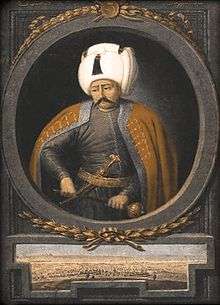 |
Selim I | 1517 – 21 September 1520 |
| ||
| 75 |  |
 |
Suleiman I | 30 September 1520 – 6 or 7 September 1566 |
|
|
| 76 | 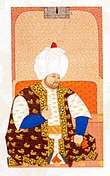 |
Selim II | 29 September 1566 – 21 December 1574 |
|
| |
| 77 | 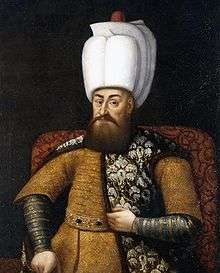 |
Murad III | 22 December 1574 – 16 January 1595 |
|
| |
| 78 | _Enthroned%2C_Attended_by_Two_Janissaries_LACMA_M.85.237.34.jpg) |
Mehmed III | 27 January 1595 – 20 or 21 December 1603 |
|
| |
| 79 | 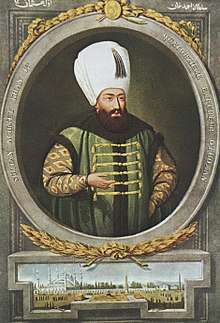 |
Ahmed I | 21 December 1603 – 22 November 1617 |
|
| |
| 80 | .jpg) |
Mustafa I | 22 November 1617 – 26 February 1618 (First reign)
20 May 1622 – 10 September 1623 (Second reign) |
|
| |
| 81 | Osman II | 26 February 1618 – 19 May 1622 |
|
| ||
| 82 |  |
Murad IV | 10 September 1623 – 8 or 9 February 1640 |
|
| |
| 83 | 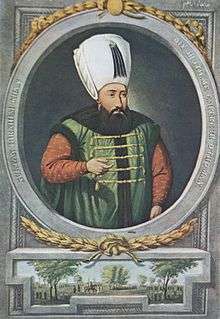 |
Ibrahim | 9 February 1640 – 8 August 1648 |
|
| |
| 84 | 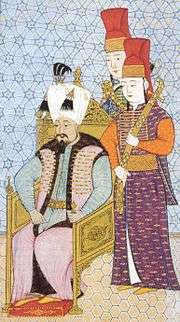 |
Mehmed IV | 8 August 1648 – 8 November 1687 |
|
| |
| 85 | 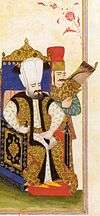 |
Suleiman II | 8 November 1687 – 22 June 1691 |
|
| |
| 86 | 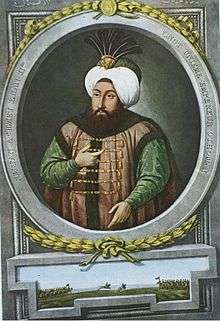 |
Ahmed II | 22 June 1691 – 6 February 1695 |
|
| |
| 87 | 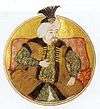 |
Mustafa II | 6 February 1695 – 22 August 1703 |
|
| |
| 88 | 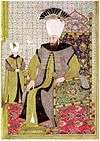 |
Ahmed III | 22 August 1703 – 1 or 2 October 1730 |
|
| |
| 89 | 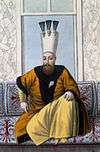 |
Mahmud I | 2 October 1730 – 13 December 1754 |
|
| |
| 90 | 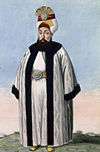 |
Osman III | 13 December 1754 – 29 or 30 October 1757 |
|
| |
| 91 | 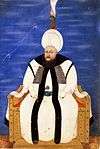 |
Mustafa III | 30 October 1757 – 21 January 1774 |
| ||
| 92 | 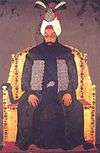 |
Abdülhamid I | 21 January 1774 – 6 or 7 April 1789 |
|
| |
| 93 | 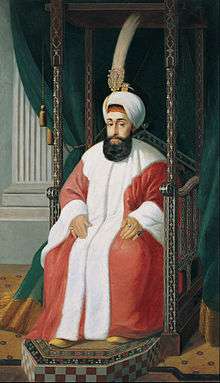 |
Selim III | 7 April 1789 – 29 May 1807 |
|
| |
| 94 | 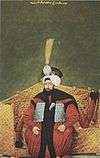 |
Mustafa IV | 29 May 1807 – 28 July 1808 |
| ||
| 95 | 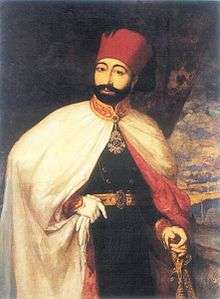 |
Mahmud II | 28 July 1808 – 1 July 1839 | Abdülhamid I |
| |
| 96 |  |
Abdülmecid I | 1 July 1839 – 25 June 1861 |
|
| |
| 97 | Abdülaziz I | 25 June 1861 – 30 May 1876 |
|
| ||
| 98 | 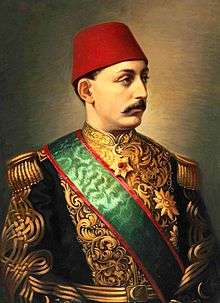 |
Murad V | 30 May 1876 – 31 August 1876 |
|
| |
| 99 |  |
 |
Abdülhamid II | 31 August 1876 – 27 April 1909 |
|
|
| 100 | 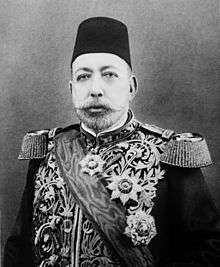 |
 |
Mehmed V | 27 April 1909 – 3 July 1918 |
|
|
| 101 |  |
 |
Mehmed VI | 4 July 1918 – 1 November 1922 |
|
|
| 102 | 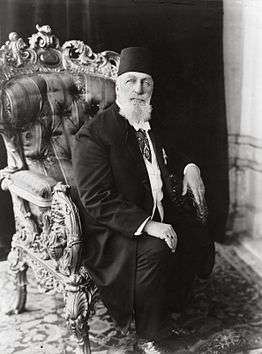 |
— [c] |
Abdülmecid II | 18 November 1922 – 3 March 1924 |
|
|
The Office of the Caliphate was transferred to the Grand National Assembly of Turkey which dissolved the office on March 3, 1924, in keeping with the policies of secularism that were adopted in the early years of the Republic of Turkey by its President Mustafa Kemal Atatürk.
After the dissolution of the Office of the Caliphate, the Grand National Assembly of Turkey founded the Presidency of Religious Affairs as the new highest Islamic religious authority in the country.
Non-ecumenical caliphates
Caliphates not accepted as legitimate by the majority of muslims.
Ibn al-Zubayr's Caliphate (684–692)
Abd Allah ibn al-Zubayr, the nephew of Aisha, the third wife of Muhammad led a rebellion against the Umayyad Caliphate in 684 AD. He was proclaimed caliph in Mecca but was defeated and killed there in 692 AD after a six-month siege by general Al-Hajjaj ibn Yusuf.[46]
Ummayad Caliphate of Córdoba (929–1031)
(Not universally accepted; actual authority confined to Spain and parts of Maghreb)[47][48]
| Name | Reign | Parents | Notes |
|---|---|---|---|
| Abd-ar-Rahman III | 929–961 |
|
|
| Al-Hakam II | 961–976 |
|
|
| Hisham II al-Hakam | 976–1009 (First reign)
1010–1013 (Second reign) |
||
| Muhammad II | 1009 |
|
|
| Sulayman ibn al-Hakam | 1009–1010 (First reign)
1013–1016 (Second reign) |
|
|
| Abd ar-Rahman IV | 1021–1022 |
|
|
| Abd ar-Rahman V | 1022–1023 |
|
|
| Muhammad III | 1023–1024 |
|
|
| Hisham III | 1027–1031 |
|
Fatimid Caliphate (909–1171)
(The Fatimids belonged to the Isma'ili branch of Shia Islam and hence are not recognized by the majority of Sunnis, whether subjects in their dominions, or from neighboring states).[49][50]
| Name | Reign | Parents | Notes |
|---|---|---|---|
| Al-Mahdi Billah | 909–934 | ||
| Al-Qa'im Bi-Amrillah | 934–946 | ||
| Al-Mansur Billah | 946–953 | ||
| Al-Muizz Lideenillah | 953–975 | Egypt is conquered during his reign | |
| Al-Aziz Billah | 975–996 | ||
| Al-Hakim bi-Amr Allah | 996–1021 | ||
| Ali az-Zahir | 1021–1036 | ||
| Al-Mustansir Billah | 1036–1094 | ||
| Al-Musta'li | 1094–1101 | Quarrels over his succession led to the Nizari split | |
| Al-Amir | 1101–1130 | The Fatimid rulers of Egypt after him are not recognized as Imams by Mustaali Taiyabi Isma'ilis | |
| Al-Hafiz | 1130–1149 |
|
|
| Al-Zafir | 1149–1154 | ||
| Al-Faiz | 1154–1160 | ||
| Al-Azid | 1160–1171 |
|
Almohad Caliphate (1145–1269)

(Not widely accepted, actual dominions were parts of North Africa and Iberia)[51][52]
| Name | Reign | Notes |
|---|---|---|
| Abd al-Mu'min | 1145–1163 | |
| Abu Yaqub Yusuf I | 1163–1184 | |
| Yaqub al-Mansur | 1184–1199 | |
| Muhammad an-Nasir | 1199–1213 | |
| Abu Ya'qub Yusuf II | 1213–1224 | |
| Abd al-Wahid I | 1224 | |
| Abdallah al-Adil | 1224–1227 | |
| Yahya | 1227–1235 | |
| Idris I | 1227–1232 | |
| Abdul-Wahid II | 1232–1242 | |
| Ali | 1242–1248 | |
| Umar | 1248–1266 | |
| Idris II | 1266–1269 |
Sokoto Caliphate (1804–1903)
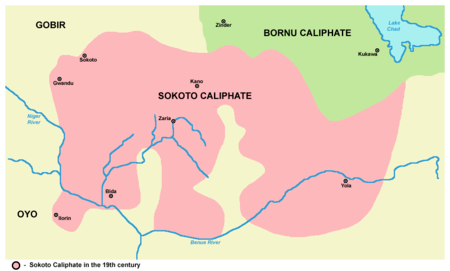
(Not widely accepted, actual dominions were parts of West Africa)
Established by Tariqa Islamic scholar and religious leader Usman dan Fodio through the Fulani War (alternatively known as the Fulani Jihad), which sought to reduce the influence of pre-Islamic religious practices and spread a more vigorous form of Islam through the auspices of a Caliphate.
Bornu and Songhai Empires

Several rulers of West Africa adopted the title of Caliph. Mai Ali Ghaji ibn Dunama was the first ruler of Bornu Empire to assume the title. Askia Mohammad I of Songhai Empire also assumed the title around the same time.[53]
Non-ecumenical caliphates declared after 1900
Since the dissolution of the Ottoman Empire, there has been no single recognized, "ecumenical" caliphate.
Sharifian Caliphate (1924–1931)

A last attempt at restoring the caliphal office and style with ecumenical recognition was made by Hussein bin Ali, King of Hejaz and Sharif of Mecca, who assumed both on 11 March 1924 and held them until 3 October 1924, when he passed the kingship to his son `Ali ibn al-Husayn al-Hashimi, who did not adopt the caliphal office and style.[54] Hussein's claim for caliphate was not accepted however, and in 1925 he was driven from Hejaz by the forces of Ibn Saud due to his lack of support for Shari'ah. He continued to use the title of caliph during his remaining life in exile, until his death in 1931. Like the Rashidun, Umayyad, Abbasid and Fatimid caliphs, he was a descendant of Muhammad through a grandson of Hasan ibn Ali.
Ahmadiyya Caliphate (1908–present)

Khalīfatul Masīh (Arabic: خليفة المسيح; Urdu: خلیفہ المسیح; English: Successor of the Messiah) or Khalifa of Ahmadiya Community [55] sometimes simply referred to as Khalifah (i.e. Caliph, successor) is the elected spiritual and organizational leader of the worldwide Ahmadiyya Community and is the successor of Mirza Ghulam Ahmad of Qadian who had claimed to be the Mahdi and Messiah in their community. The Caliph is believed to be divinely guided and is also referred to by members of the Ahmadiyya Community as Amir al-Mu'minin (Leader of the Faithful). The fifth and current Khalifatul Masih is Mirza Masroor Ahmad. The rest of the major sections of Islam that are Sunni and Shiya, do not believe in this caliphate system.
After the death of Ghulam Ahmad, his successors directed the Ahmadiyya Community from Qadian which remained the headquarters of the community until 1947 with the creation of Pakistan. From this time on the headquarters remained in Rabwah, a town built on land bought in Pakistan by the community in 1948. In 1984, Ordinance XX was promulgated by the government of Pakistan which rendered the Khalifatul Masih unable to perform his duties and put the very institution in jeopardy. Due to these circumstances, Khalifatul Masih IV left Pakistan and migrated to London, England, provisionally moving the headquarters to the Fazl Mosque.[56]
ISIL/ISIS claim (2014–present)
On 29 June 2014, the Islamic State of Iraq and the Levant (ISIL) started to call itself "Islamic State" and call its leader Abu Bakr al-Baghdadi "caliph Ibrahim".[57][58] The validity of this caliphate has not been recognized by any Islamic authority outside of the 10-million-people territory[59] under control of Islamic State.[60]
On 24 August 2014, the leader of Boko Haram in Nigeria, Abubakar Shekau, likewise declared a caliphate. Apparently, it remained unclear whether Shekau declared his group to be part of ISIL or if he was declaring a separate caliphate in Nigeria.[61] On 7 March 2015, Shekau pledged allegiance to ISIL via an audio message posted on the organisation's Twitter account.[62][63] Afterwards, Boko Haram assumed the name "Wilāyat al Sūdān al Gharbī" (Arabic: ولاية السودان الغربي, "West Africa Province") or "Islamic State in West Africa" (Iswap).[64] However, on the 10th of April, 2018, during a rally headlined by U.S. President Donald Trump in support of Mike Braun’s bid for the US Senate in Elkhart, Indiana, Vice President Mike Pence referred to ISIS as a Caliphate, claiming “ISIS is on the run, their Caliphate has crumbled, and we will soon drive them out of existence once and for all,” implying the US views the claims of Baghdadi as (at least rhetorically) legitimate. [65]
 ISIL Flag (Black Standard).
ISIL Flag (Black Standard).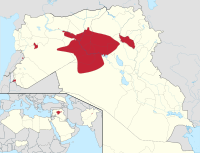 Areas controlled by ISIL Areas in which ISIL has claimed to have presence or control[66]
Areas controlled by ISIL Areas in which ISIL has claimed to have presence or control[66] Areas controlled by Wilāyat al Sūdān al Gharbī (as of 10 April 2015)
Areas controlled by Wilāyat al Sūdān al Gharbī (as of 10 April 2015) The greatest extent of Wilāyat al Sūdān al Gharbī (in January 2015)
The greatest extent of Wilāyat al Sūdān al Gharbī (in January 2015)
See also
References
- ↑ Majd, Vahid. The Sermon of Prophet Muhammad (saww) at Ghadir Khum. pp. 17–18.
- ↑ "A Shi'ite Encyclopedia". Al-Islam.org. Ahlul Bayt Digital Islamic Library Project. Retrieved 27 February 2018.
- ↑ Musnad Ahmad Ibn Hanbal, Volume 4. p. 281.
- ↑ al-Razi, Fakhr. Tafsir al-Kabir, Volume 12. pp. 49–50.
- ↑ "Imam Hassan as". Duas.org.
- ↑ Lane-Poole 2004, pp. 12–13
- ↑ Bosworth 2004, pp. 6–7
- ↑ Al-Mudaffar, Sheikh Muhammad Al-Hussein. Imam Jafar Sadiq. p. 291.
- ↑ ibn Maja (1368). al-Sunan, II.
- ↑ Bosworth 2004, p. 7
- ↑ Houtsma & Wensinck 1993, p. 3
- ↑ Lane-Poole 2004, p. 195
- ↑ Bosworth 2004, pp. 239–240
- ↑ Lambton, Ann; Lewis, Bernard (1995). The Cambridge History of Islam: The Indian sub-continent, South-East Asia, Africa and the Muslim west. 2. Cambridge University Press. p. 320. ISBN 9780521223102. Retrieved 14 March 2015.
- ↑ "Yavuz Sultan Selim Han". Republic of Turkey Ministry of Culture and Tourism. Retrieved 2009-02-06.
- ↑ "Kanuni Sultan Süleyman Han". Republic of Turkey Ministry of Culture and Tourism. Retrieved 2009-02-06.
- ↑ "Sultan II. Selim Han". Republic of Turkey Ministry of Culture and Tourism. Retrieved 2009-02-06.
- ↑ "Sultan III. Murad Han". Republic of Turkey Ministry of Culture and Tourism. Retrieved 2009-02-06.
- ↑ "Sultan III. Mehmed Han". Republic of Turkey Ministry of Culture and Tourism. Retrieved 2009-02-06.
- ↑ "Sultan I. Ahmed". Republic of Turkey Ministry of Culture and Tourism. Retrieved 2009-02-06.
- 1 2 "Sultan I. Mustafa". Republic of Turkey Ministry of Culture and Tourism. Retrieved 2009-02-06.
- ↑ "Sultan II. Osman Han". Republic of Turkey Ministry of Culture and Tourism. Retrieved 2009-02-06.
- ↑ "Sultan IV. Murad Han". Republic of Turkey Ministry of Culture and Tourism. Retrieved 2009-02-06.
- ↑ "Sultan İbrahim Han". Republic of Turkey Ministry of Culture and Tourism. Retrieved 2009-02-06.
- ↑ "Sultan IV. Mehmed". Republic of Turkey Ministry of Culture and Tourism. Retrieved 2009-02-06.
- ↑ "Sultan II. Süleyman Han". Republic of Turkey Ministry of Culture and Tourism. Retrieved 2009-02-06.
- ↑ "Sultan II. Ahmed Han". Republic of Turkey Ministry of Culture and Tourism. Retrieved 2009-02-06.
- ↑ "Sultan II. Mustafa Han". Republic of Turkey Ministry of Culture and Tourism. Retrieved 2009-02-06.
- ↑ "Sultan III. Ahmed Han". Republic of Turkey Ministry of Culture and Tourism. Retrieved 2009-02-06.
- ↑ "Sultan I. Mahmud Han". Republic of Turkey Ministry of Culture and Tourism. Retrieved 2009-02-06.
- ↑ "Sultan III. Osman Han". Republic of Turkey Ministry of Culture and Tourism. Retrieved 2009-02-06.
- ↑ "Sultan III. Mustafa Han". Republic of Turkey Ministry of Culture and Tourism. Retrieved 2009-02-06.
- ↑ "Sultan I. Abdülhamit Han". Republic of Turkey Ministry of Culture and Tourism. Retrieved 2009-02-06.
- ↑ "Sultan III. Selim Han". Republic of Turkey Ministry of Culture and Tourism. Retrieved 2009-02-06.
- ↑ "Sultan IV. Mustafa Han". Republic of Turkey Ministry of Culture and Tourism. Retrieved 2009-02-06.
- ↑ "Sultan II. Mahmud Han". Republic of Turkey Ministry of Culture and Tourism. Retrieved 2009-02-06.
- ↑ "Sultan Abdülmecid Han". Republic of Turkey Ministry of Culture and Tourism. Retrieved 2009-02-06.
- ↑ "Sultan Abdülaziz Han". Republic of Turkey Ministry of Culture and Tourism. Retrieved 2009-02-06.
- ↑ "Sultan V. Murad Han". Republic of Turkey Ministry of Culture and Tourism. Retrieved 2009-02-06.
- ↑ "Sultan II. Abdülhamid Han". Republic of Turkey Ministry of Culture and Tourism. Retrieved 2009-02-06.
- ↑ "Sultan V. Mehmed Reşad Han". Republic of Turkey Ministry of Culture and Tourism. Retrieved 2009-02-06.
- ↑ "Sultan VI. Mehmed Vahdettin Han". Republic of Turkey Ministry of Culture and Tourism. Retrieved 2009-02-06.
- ↑ As̜iroğlu 1992, p. 13
- ↑ As̜iroğlu 1992, p. 17
- ↑ As̜iroğlu 1992, p. 14
- ↑ Dictionary of Battles and Sieges: F-O edited by Tony Jacques
- ↑ Lane-Poole 2004, p. 21
- ↑ Bosworth 2004, p. 11
- ↑ Lane-Poole 2004, p. 71
- ↑ Bosworth 2004, p. 63
- ↑ Lane-Poole 2004, p. 47
- ↑ Bosworth 2004, p. 39
- ↑ Nehemia Levtzion, Randall Pouwels. The History of Islam in Africa. Ohio University Press. p. 81.
- ↑ Bosworth 2004, p. 118
- ↑ http://www.caliphofislam.com Archived 2014-12-19 at the Wayback Machine.
- ↑ "Khilafat - Caliphate - The Guided Khilafat - Khilafat e Ahmadiyya - Al Islam Online". www.alislam.org.
- ↑ Adam Withnall (2014-06-30). "Iraq crisis: Isis declares its territories a new Islamic state with 'restoration of caliphate' in Middle East - Middle East - World". The Independent. Retrieved 2014-07-04.
- ↑ "ISIS Spokesman Declares Caliphate, Rebrands Group as "Islamic State"". SITE Institute. 29 June 2014. Retrieved 29 June 2014.
- ↑ "Islamic State-controlled parts of Syria, Iraq largely out of reach: Red Cross". 13 March 2015 – via Reuters.
- ↑ Yusuf al-Qaradawi stated: "[The] declaration issued by the Islamic State is void under sharia and has dangerous consequences for the Sunnis in Iraq and for the revolt in Syria", adding that the title of caliph can "only be given by the entire Muslim nation", not by a single group. Strange, Hannah (5 July 2014). "Islamic State leader Abu Bakr al-Baghdadi addresses Muslims in Mosul". The Telegraph. Retrieved 6 July 2014.
- ↑ Boko Haram leader declares Islamic caliphate in Nigeria , Washington Times, 24 August 2014.
- ↑ "Nigeria's Boko Haram pledges allegiance to Islamic State". BBC news. BBC. 2015-03-07. Retrieved 2015-03-07.
- ↑ Adam Chandler (March 9, 2015). "The Islamic State of Boko Haram? :The terrorist group has pledged its allegiance to ISIS. But what does that really mean?". The Atlantic.
- ↑ "Africa blog: Islamic State strengthens ties with Boko Haram". BBC News. Retrieved 25 April 2015.
- ↑ Trump TV Network (2018-05-10), FULL EVENT: President Donald Trump MASSIVE Rally in Elkhart, Indiana - May 10, 2018, retrieved 2018-05-12 . See 6:00
- ↑ "Battle for Iraq and Syria in maps". BBC News. 3 December 2014. Retrieved 5 December 2014.
Bibliography
- Bosworth, Clifford Edmund (2004) [1996]. The New Islamic Dynasties: A Chronological and Genealogical Manual. New Edinburgh Islamic Surveys (2nd ed.). Edinburgh University Press. ISBN 978-0-7486-2137-8. OCLC 56639413.
- Houtsma, M. Th.; Wensinck, A. J. (1993). E.J. Brill's First Encyclopaedia of Islam 1913–1936 (Reprint)
|format=requires|url=(help). Volume IX. Leiden: BRILL. ISBN 978-90-04-09796-4. - Lane-Poole, Stanley (1894). The Mohammedan Dynasties: Chronological and Genealogical Tables with Historical Introductions. Westminster: Archibald Constable and Company. OCLC 1199708.
